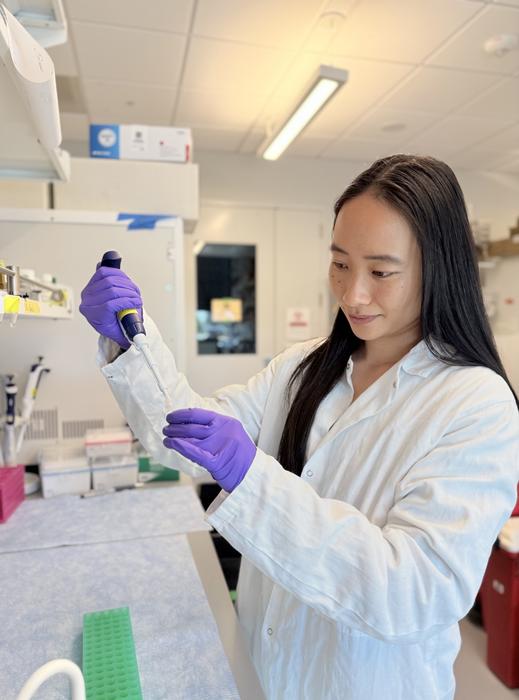In a groundbreaking development poised to redefine the landscape of neurodegenerative disease research, Dr. Sophia Shi, a rising star in the field of neurobiology and glycobiology, has unveiled pioneering findings that elucidate the heretofore underappreciated role of sugar molecules in brain aging. Her investigative focus centers on the glycocalyx, a dense, intricate layer of glycoproteins and polysaccharides coating the endothelial cells of the blood-brain barrier (BBB). This molecular “forest” emerges as a critical protective interface, maintaining vascular integrity and modulating neuroinflammatory processes that are central to cognitive decline and diseases such as Alzheimer’s.
The blood-brain barrier, historically conceptualized as a simple, static wall guarding the brain’s microenvironment, is now understood through Dr. Shi’s work as a dynamic, sugar-coated structure. The glycocalyx forms a biochemical and biomechanical shield that orchestrates selective permeability and protects neural tissue from systemic insults. Aging leads to a pronounced deterioration of this structure, diminishing its barrier function and precipitating neuroinflammation. Dr. Shi’s research, recently published in the prestigious journal Nature, reveals this degradation as a fundamental mechanism driving the onset and progression of neurodegenerative pathologies.
What sets Dr. Shi’s work apart is her successful demonstration of restoring the glycocalyx in aged murine models, an achievement that challenges long-standing assumptions about the irreversibility of age-associated BBB dysfunction. By replenishing mucin-type O-glycans—complex sugar chains attached to proteins integral to the glycocalyx—her team observed robust improvements in vascular integrity and cognitive performance. This restoration not only reestablishes the physical barrier but also attenuates neuroinflammatory cascades implicated in neuronal damage, signifying a paradigm shift in therapeutic strategies.
Dr. Shi’s journey to these insights is as interdisciplinary as it is innovative. Her initial fascination with puzzles and patterns laid the cognitive groundwork for dissecting the elaborate and often elusive language of glycosylation. Mentor-guided training under Nobel laureate Carolyn Bertozzi, a pioneer in chemical glycobiology, and neurobiologist Tony Wyss-Coray, known for his work on the aging brain, provided a unique intellectual environment. This confluence of expertise enabled Dr. Shi to bridge molecular glycobiology with complex neurological systems, addressing questions that have historically resisted traditional methodological approaches.
Technically, the study employed advanced live-tissue imaging techniques coupled with mass spectrometry-based glycomic profiling, allowing unprecedented visualization and quantification of glycocalyx alterations in vivo. These techniques overcome the classical challenges of studying glycan structures, which due to their heterogeneity and dynamic modification patterns, evade routine protein-centric analyses. Dr. Shi’s methodological innovation highlights the power of integrating chemical biology with neuroscience to uncover molecular underpinnings of brain aging.
The therapeutic implications are profound. Current Alzheimer’s disease interventions largely focus on symptomatic relief or targeting hallmark protein aggregates like amyloid-beta or tau. Dr. Shi’s approach shifts this paradigm towards preserving vascular and metabolic integrity by targeting the glycocalyx. By identifying specific glycosylation patterns as actionable drug targets, her work opens avenues for precision therapeutics aimed at reinforcing the blood-brain barrier’s natural defenses, potentially delaying or halting neurodegeneration at its vascular roots.
Dr. Shi’s findings also evoke critical questions for future exploration: At what age do glycocalyx alterations begin in the human brain? Are there genetic predispositions or environmental factors that exacerbate glycocalyx loss? Could lifestyle interventions enhance glycocalyx robustness? Addressing these will require longitudinal human studies and nuanced experimental designs, but Dr. Shi’s establishment of an independent laboratory at Harvard signifies a committed effort to pursue these challenging inquiries.
Moreover, Dr. Shi highlights the broader implications of post-translational modifications, such as glycosylation, in modulating protein function in neural contexts. These subtle biochemical decorations can drastically influence receptor activity, cell signaling, and immune interactions—domains critical to brain homeostasis yet historically overlooked in aging research. Her advocacy for elevating glycoscience within neuroscience underscores a need for expanded interdisciplinary collaborations and funding priorities.
Beyond her scientific breakthroughs, Dr. Shi embodies a dedication to fostering inclusivity within research culture. She openly acknowledges the barriers faced by many in STEM fields, particularly those lacking early exposure or mentorship. Through outreach and mentorship programs, she aims to cultivate an environment where diversity in thought and background accelerates innovation, reflecting the multifaceted nature of complex biomedical challenges.
Her personal interests in hiking and trail running metaphorically resonate with her approach to science: persistent, strategic exploration of difficult terrains and seeking novel vantage points to solve intricate puzzles. This blend of rigorous scientific inquiry with human experience injects vitality into an often reductionist discipline, reminding us that transformative research is as much about curiosity and resilience as it is about data.
Dr. Shi’s revelations challenge existing dogmas and suggest that many prior therapeutic failures may have stemmed from an incomplete understanding of the BBB’s molecular ecology. Recognizing the glycocalyx as a central participant in brain aging lures a rethinking of preventive medicine toward maintaining vascular sugar coatings as an integral component of long-term brain health maintenance.
The breadth and depth of this work, featured in Brain Medicine, highlight a growing shift toward translational, cross-disciplinary research that bridges fundamental neurobiology with clinical applications. Dr. Shi’s interview in the Innovators & Ideas series presented by Genomic Press offers not only insight into cutting-edge science but also showcases the personal narratives fueling next-generation biomedical discoveries.
As the scientific community digests these findings, the potential ripple effects across neurology, geriatrics, and pharmacology are monumental. Dr. Shi’s glycocalyx-focused research stands as a beacon signaling the arrival of new therapeutic avenues—ones that might one day transform how humanity confronts the devastating toll of neurodegenerative diseases.
Subject of Research: People
Article Title: Sophia Shi: Decoding the role of sugar molecules in brain aging and neurodegenerative diseases
News Publication Date: 10 June 2025
Web References: https://doi.org/10.61373/bm025k.0074
References: Shi S, et al. Nature (publication details unspecified here)
Image Credits: Dr. Sophia Shi
Keywords: Blood-brain barrier, glycocalyx, glycosylation, neurodegeneration, Alzheimer’s disease, mucin-type O-glycans, brain aging, neuroinflammation, glycobiology, translational neuroscience




